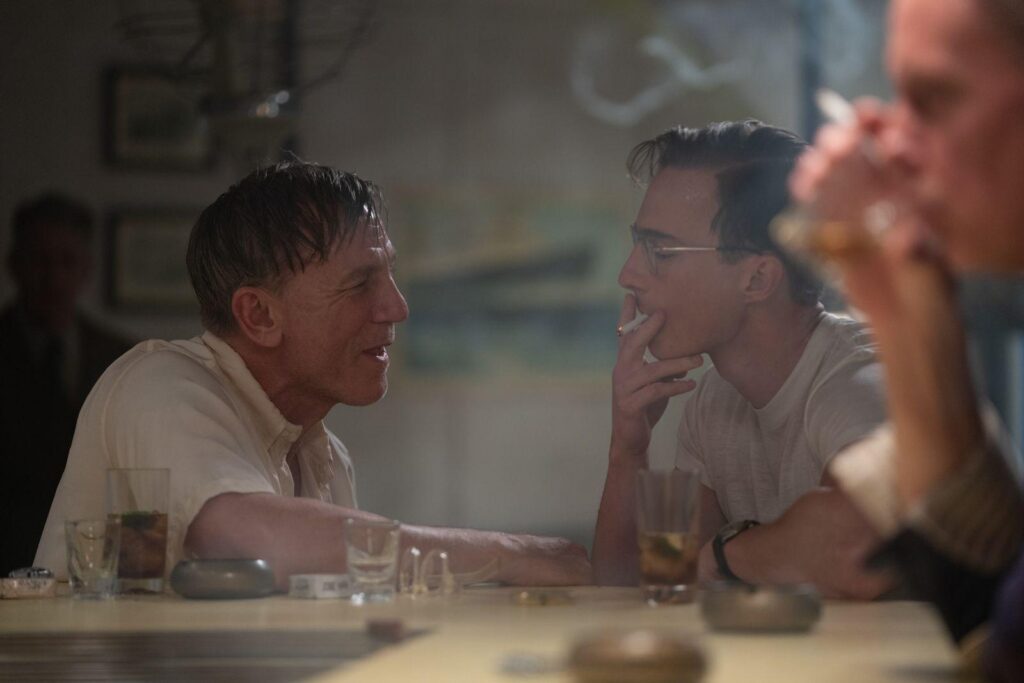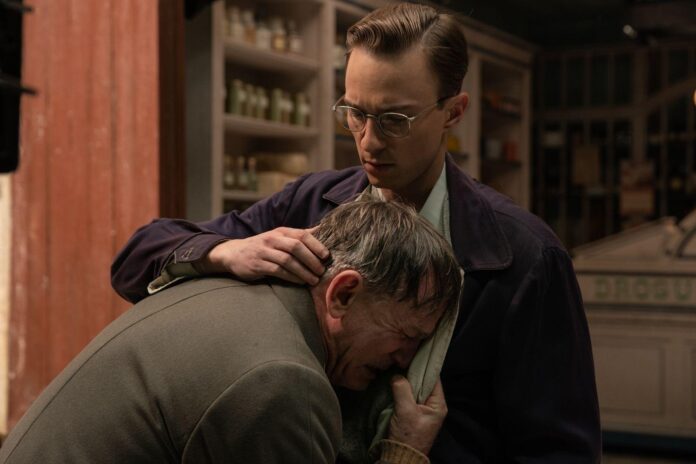Luca Guadagnino’s “Queer,” adapted from William S. Burrough’s novel, is a dark, and at times surreal drama about addiction. The director’s films are nothing if not achievements in style, and this richly colored film is full of textures — from the fabulous period clothes (the film is set in the 1950s) to its strange, hallucinatory images.
Lee (Daniel Craig) is a gay junkie and a “man of independent means.” He is living in Mexico, where he mostly looks for drinks and sex. “Are you queer?” He asks a possible companion for the evening. He is turned down as often as he succeeds. A seductive encounter with a young Mexican (Omar Apollo) provides an erotic tryst in a hotel room. But it also suggests both his despair and his desperation. Guadagnino captures Lee’s ennui well, as does Daniel Craig in a performance that should secure him his first Oscar nomination.
When Lee catches sight of Allerton (Drew Starkey), a tall drink of water who frequents his favorite bar, Lee is smitten. Especially when Lee later eyes Allerton at a cockfight in the street. The moment is transfixing. Is Allerton queer? Lee sure as hell hopes so. He becomes addicted to this guy as if Allerton is the drug Lee also craves. Lee’s goofy lovesick expression when Allerton passes him indicates just how gone Lee is.
The way Craig purses his lips throughout the film indicates so much longing and disdain; is he admiring or silently criticizing? When the two men actually spend some time together, Lee imagines reaching his hand out and stroking Allerton’s face in a scene of fabulist intimacy.
As Allerton spends more time with Lee, however, it is unclear if Allerton is just flirting or really interested. That frisson propels the film to a night when Lee invites Allerton back to his apartment. Guadagnino’s intentional direction focuses on the doorknob signaling that things are going to get intense. And once Lee ushers Allerton into the bedroom, they do. “Queer” features an erotic sex scene between the men that will likely send viewers into ecstasy.
But after this encounter, Allerton is more aloof, and Lee wonders if there is a way to catch this “cold, slippery fish”— as Lee’s friend Joe (a portly and amusing Jason Schwartzman), calls the possibly straight Allerton. Lee invites the man he is besotted with to join Lee on a trip to South America as Lee is keen to secure some hallucinogens. In exchange, all Allerton needs to do is be “nice” to Lee — “twice a week.”

“Queer” shifts gears in its second act as the men become traveling companions. The trip starts off rockily as Lee gets junk sick and requires a visit to a doctor to handle his addiction to opiates. The men do spend some time in bed together, cuddling when Lee is cold, and have sex after Lee is cured. Again, Lee’s hand reaching out to Allerton expresses so much unspoken desire. While Guadagnino cuts away from the bodies in bed to show the outdoor landscape (something he also did in his gay romance, “Call Me by Your Name”) he does cut back to show Lee and Allerton having sex.
The scenes of Craig and Drew Starkey being intimate are admirable. But the next morning, over breakfast, Allerton is far less pliant when Lee strokes his head and neck. The hot-and-cold relationship is frustrating for Lee who starts to pursue his other passion — the Yage drug — in the jungle.
The action shifts again as Lee and Allerton meet Dr. Cotter (Leslie Manville) to “explore the properties of the drug.” Lee’s interest in Yage is as baldly concealed as his interest in Allerton. He turns on the naughty charm for Dr. Cotter, but he is so transparent she applauds him — just as long as he doesn’t have ulterior motives.
Lee is only interested in sensory pleasures and “Queer” gets trippy as Lee and Allerton imbibe the drugs and have out-of-body experiences. Literally. One scene of the men naked and embracing features their hands under each other’s skin. It is an especially arresting image. But these scenes have less emotional impact than the film’s seductive first act. The relationship between the men has changed, and as it plays out through a series of increasingly surreal moments, the film becomes more opaque. “Queer” even includes a game of William Tell where Lee tries shooting a glass off Allerton’s head, echoing an infamous moment in Burroughs’ life. But fatigue sets in before this episode occurs.
Guadagnino lards his film with wondrous images, such as a snake eating its own tail, to convey Lee’s self-destructive tendencies, but it is Craig’s moody, desperate performance that makes “Queer” so rapturous. The actor throws himself into the role with abandon, hungrily pursuing his desires of sex and drugs. In what may be the film’s greatest scene, Lee prepares to inject himself with heroin and just sits waiting for the drugs to take effect. It’s shot in real time and Craig’s demeanor reflects both his anticipation and release. It is a remarkable performance.
Drew Starkey is also impressive as Allerton, but he is best when he keeps an air of mystery about him. Watching Lee navigate what Allerton will permit is compelling, but as the film progresses, Allerton becomes less intriguing due to his underdeveloped character.
“Queer” certainly enthralls as it maintains a hypnotic pull on viewers, but it may also lose some folks along the way.
